
FACULTY OF ENGINEERING
Department of Aerospace Engineering
GEAR 214 | Course Introduction and Application Information
| Course Name |
Presentation Skills in Communication
|
|
Code
|
Semester
|
Theory
(hour/week) |
Application/Lab
(hour/week) |
Local Credits
|
ECTS
|
|
GEAR 214
|
Fall/Spring
|
1
|
2
|
3
|
4
|
| Prerequisites |
None
|
|||||
| Course Language | ||||||
| Course Type |
Second Foreign Language
|
|||||
| Course Level |
-
|
|||||
| Mode of Delivery | - | |||||
| Teaching Methods and Techniques of the Course | - | |||||
| Course Coordinator | - | |||||
| Course Lecturer(s) | ||||||
| Assistant(s) | - | |||||
| Course Objectives | This course aims to improve in students two very important and desirable skills in interpersonal communication: (1) Communicating effectively and efficiently using audio-visual media; (2) Persuading the audience into complying with the aim of the presentation / presenter. |
| Learning Outcomes |
The students who succeeded in this course;
|
| Course Description | This course aims to equip the students with the fifth language proficiency skill: Sharing information through effective presentations (the original four were: Listening, Speaking, Reading, Writing) It aims to create awareness regarding the importance of interpersonal communication skills and does this through both theory and practice. |
|
|
Core Courses | |
| Major Area Courses | ||
| Supportive Courses | ||
| Media and Management Skills Courses | ||
| Transferable Skill Courses |
WEEKLY SUBJECTS AND RELATED PREPARATION STUDIES
| Week | Subjects | Related Preparation |
| 1 | Introduction of Lecture Sources and Software Explanation of the general design and approach of the course. First exposure to the process of communication, past and present. | Just come to class with an open mind. |
| 2 | Weekly subjects, presentations skills, verbal / non-verbal communication Non-verbal communication in more detail | Course Book: Business Communication Today, Bovée, Courtland, & Thill, John V., 12th Edition, 2014, Prentice Hall, |
| 3 | Warm up: Why you need presentation skills, importance of communication in business, FAQ / Q&A, The meaning of effective communication | Chapter 1 (pp 40 – 68) |
| 4 | 5W1H approach to successful communication Secrets of successful orators | Chapter 4 (pp 123 – 148) |
| 5 | Express your feelings through role-play Sample presentations | Chapter 5 (pp 152 – 177) |
| 6 | What to present: Content, idea, tip Idea generation techniques: Story-teller's tour, Brain-storming, Utilizing field sources, et al. | Chapter 6 (pp 182 – 206) |
| 7 | Persuasive messages: AIDA as the road plan Sample presentations | Chapter 12 |
| 8 | How to find and process information Secondary sources Primary sources How to present words, typography, visuals, symbols, fonts and other written characters, use of colors | Chapter 7, 8, 9 summary; Short review of Chapter 6 Steve Jobs in Apple videos |
| 9 | How to write a manuscript format report as a basis for the presentation | Chapters 14 and 15 (pp 437 – 494) |
| 10 | How to prepare a professional presentation | Chapters 16 and 17 (pp 506 – 552) |
| 11 | MIDTERM EXAM | |
| 12 | Student Presentations | |
| 13 | Student Presentations | |
| 14 | Student Presentations | |
| 15 | Review of the semester | |
| 16 | Final Project |
| Course Notes/Textbooks | Course Book: Business Communication Today, Bovée, Courtland, & Thill, John V., 12th Edition, 2014, Prentice Hall, |
| Suggested Readings/Materials | A long list to be presented by the Lecturer on the opening day TED talks Videos to be supplied by the Lecturer |
EVALUATION SYSTEM
| Semester Activities | Number | Weigthing |
| Participation |
1
|
15
|
| Laboratory / Application | ||
| Field Work | ||
| Quizzes / Studio Critiques |
1
|
5
|
| Portfolio | ||
| Homework / Assignments |
1
|
10
|
| Presentation / Jury |
2
|
40
|
| Project | ||
| Seminar / Workshop | ||
| Oral Exams | ||
| Midterm |
1
|
30
|
| Final Exam | ||
| Total |
| Weighting of Semester Activities on the Final Grade | ||
| Weighting of End-of-Semester Activities on the Final Grade | ||
| Total |
ECTS / WORKLOAD TABLE
| Semester Activities | Number | Duration (Hours) | Workload |
|---|---|---|---|
| Theoretical Course Hours (Including exam week: 16 x total hours) |
16
|
3
|
48
|
| Laboratory / Application Hours (Including exam week: '.16.' x total hours) |
16
|
0
|
|
| Study Hours Out of Class |
0
|
||
| Field Work |
0
|
||
| Quizzes / Studio Critiques |
1
|
12
|
12
|
| Portfolio |
0
|
||
| Homework / Assignments |
1
|
20
|
20
|
| Presentation / Jury |
2
|
25
|
50
|
| Project |
0
|
||
| Seminar / Workshop |
0
|
||
| Oral Exam |
0
|
||
| Midterms |
1
|
30
|
30
|
| Final Exam |
0
|
||
| Total |
160
|
COURSE LEARNING OUTCOMES AND PROGRAM QUALIFICATIONS RELATIONSHIP
|
#
|
Program Competencies/Outcomes |
* Contribution Level
|
||||
|
1
|
2
|
3
|
4
|
5
|
||
| 1 | To have theoretical and practical knowledge that have been acquired in the area of Mathematics, Natural Sciences, and Aerospace Engineering. |
|||||
| 2 | To be able to assess, analyze and solve problems by using the scientific methods in the area of Aerospace Engineering. |
|||||
| 3 | To be able to design a complex system, process or product under realistic limitations and requirements by using modern design techniques. |
|||||
| 4 | To be able to develop, select and use novel tools and techniques required in the area of Aerospace Engineering. |
|||||
| 5 | To be able to design and conduct experiments, gather data, analyze and interpret results. |
|||||
| 6 | To be able to develop communication skills, ad working ability in multidisciplinary teams. |
|||||
| 7 | To be able to communicate effectively in verbal and written Turkish; writing and understanding reports, preparing design and production reports, making effective presentations, giving and receiving clear and understandable instructions. |
|||||
| 8 | To have knowledge about global and social impact of engineering practices on health, environment, and safety; to have knowledge about contemporary issues as they pertain to engineering; to be aware of the legal ramifications of Aerospace Engineering solutions. |
|||||
| 9 | To be aware of professional and ethical responsibility; to have knowledge about standards utilized in engineering applications. |
|||||
| 10 | To have knowledge about industrial practices such as project management, risk management, and change management; to have awareness of entrepreneurship and innovation; to have knowledge about sustainable development. |
|||||
| 11 | To be able to collect data in the area of Aerospace Engineering, and to be able to communicate with colleagues in a foreign language (‘‘European Language Portfolio Global Scale’’, Level B1). |
|||||
| 12 | To be able to speak a second foreign language at a medium level of fluency efficiently. |
|||||
| 13 | To recognize the need for lifelong learning; to be able to access information, to be able to stay current with developments in science and technology; to be able to relate the knowledge accumulated throughout the human history to Aerospace Engineering. |
|||||
*1 Lowest, 2 Low, 3 Average, 4 High, 5 Highest
NEWS |ALL NEWS
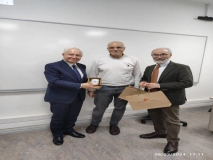
Prof. Pasquale's visit
Prof. Pasquale Daponte from the University of Benevento Sannio, Italy visited our Aerospace Engineering department during the period from 07.03 to 10.03 to discuss
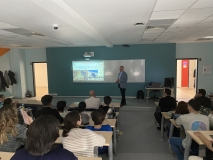
Presentation of Prof. Slawomir Szrama
Prof. Slawomir Szrama visited our university and Aerospace Engineering department during period from 04.03.2024 to 08.03.2024. He gave a talk about "Neural Networks
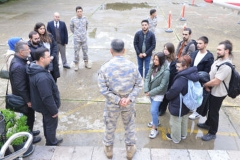
Technical Trip of The Aerospace Engineering Department to Gaziemir
A technical trip was conducted to the Aviation Sciences laboratories of the Air Force Non-Commissioned Officer Vocational School affiliated with the National
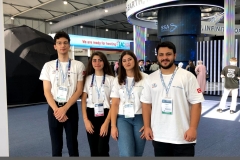
Award-winning helicopters promoted in Azerbaijan
Izmir University of Economics (IUE) students, who managed to receive awards at TEKNOFEST two years in a row with the cargo transport
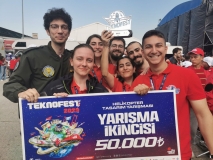
ECO-Dynamics places second in Teknofest Helicopter Design Competition with their attack helicopter
The "ECO-Dynamics" team, consisting of 7 students, Pınar Akın, Eda Nur Tetik, Kutlu Akar, Melisa Gündoğdu, Mehmet Ali Tekin, Tuna Deniz ve
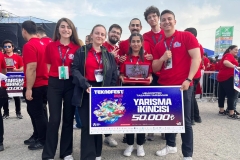
They came second with the helicopter design
The ‘ECO-Dynamics’ team, consisting of 7 students from Izmir University of Economics (IUE) Department of Aerospace Engineering,
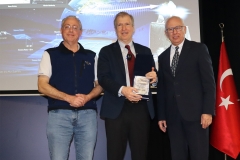
Visitor from NASA
Jay Trimble, Mission System Manager at NASA Ames Research Center, met with students at the two-day conference on NASA's Space Travel, organized


